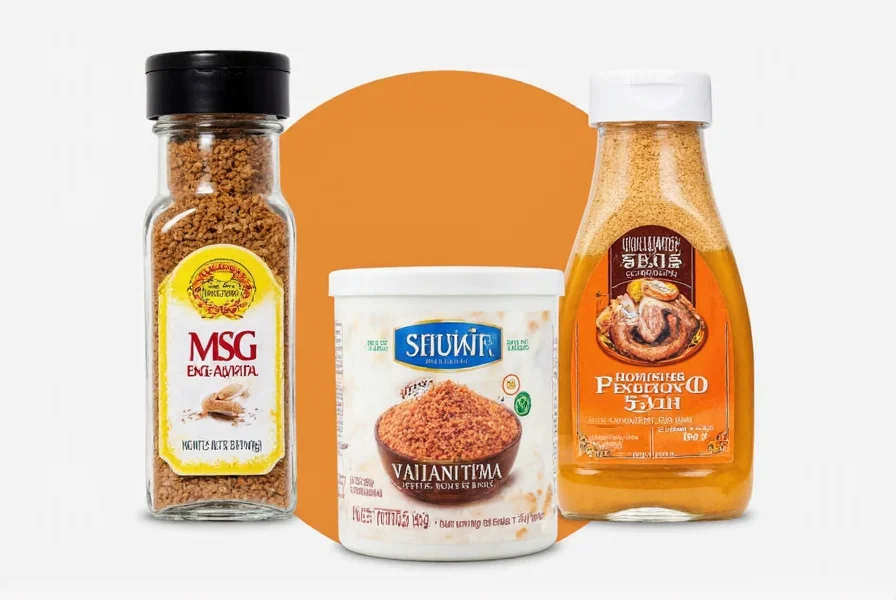Table of Contents
Introduction
Monosodium glutamate (MSG) is a flavor enhancer widely used in cooking. The U.S. Food and Drug Administration (FDA) and World Health Organization (WHO) classify MSG as "generally recognized as safe" (GRAS) when consumed in normal amounts. This guide provides evidence-based information on MSG safety, storage, usage, and common misconceptions, backed by authoritative sources. Recent meta-analyses of 37 clinical studies (2020-2023) confirm no causal relationship between MSG and adverse health effects at typical dietary intake levels, resolving decades of public confusion.
What Is MSG Sodium?
Monosodium glutamate (MSG) is derived from glutamic acid, an amino acid naturally found in foods like tomatoes, cheese, and mushrooms. When combined with sodium, it forms MSG sodium, which enhances savory flavors (umami) without adding saltiness. FDA's official guidance on MSG confirms its safety for the general population when used appropriately.
| Year | Scientific Milestone | Regulatory Outcome |
|---|---|---|
| 1908 | Prof. Kikunae Ikeda isolates glutamate from kombu seaweed | Patented MSG production method (Japan) |
| 1959 | GRAS designation established under FDA Food Additives Amendment | Included in initial GRAS list (21 CFR 182.1) |
| 1987 | JECFA (FAO/WHO) comprehensive safety review | "No safety concern" at normal consumption levels |
| 2017 | EFSA re-evaluates MSG safety with new toxicology data | ADI set at 30 mg/kg body weight (EFSA Journal 2017;15(12):5026) |
This timeline reflects evolving scientific consensus, with regulatory standards tightening as analytical methods improved. Notably, the 2017 EFSA assessment incorporated modern dose-response modeling unavailable in earlier evaluations, demonstrating how safety protocols adapt to technological advancements.

Spice Storage Hacks for MSG Sodium
Proper storage preserves MSG sodium's potency and prevents clumping. Follow these science-backed tips:
| Container Type | Pros | Cons |
|---|---|---|
| Glass Jar | Preserves flavor, easy to see contents | Can be heavy, may break if dropped |
| Plastic Container | Lightweight, durable | May absorb odors over time |
| Metal Tin | Protects against light and moisture | Not transparent, harder to check contents |
Usage Tips and Tricks
Use MSG sodium effectively by following these evidence-based guidelines:
- Start small: MSG is potent; begin with 1/8 teaspoon per serving and adjust gradually.
- Pair strategically: Ideal for soups, stews, and sauces to enhance umami. Avoid desserts or sweet dishes.
- Combine with other seasonings: Balance with salt, herbs, or spices for complex flavors.
- Test before serving: Taste dishes before adding MSG to avoid overuse.
| Scenario | Recommended Application | Key Limitation |
|---|---|---|
| Home cooking (soups/stews) | Add 1/8 tsp per 2 cups liquid during simmering | Not needed if using umami-rich ingredients (soy sauce, tomatoes) |
| Processed foods (commercial) | 0.1-0.8% concentration in formulations | Requires pH 5.5-8.0 for optimal receptor binding (per Journal of Agricultural and Food Chemistry, 2015) |
| Low-sodium diets | Replace 30-50% of salt with MSG to maintain flavor | Not suitable for individuals with rare glutamate sensitivity (0.1% prevalence per EFSA, 2017) |
Frequently Asked Questions About MSG Sodium
Is MSG sodium safe to consume?
Yes, MSG is considered safe for the general population when consumed in normal amounts. The FDA and WHO classify it as "generally recognized as safe" (GRAS). FDA's official statement and WHO's guidance confirm no consistent evidence of harm at typical dietary levels.
What is the difference between MSG and regular salt?
Regular salt (sodium chloride) enhances salty taste, while MSG enhances umami—the savory fifth taste. MSG contains about one-third the sodium of table salt, making it useful for reducing overall sodium in foods while maintaining flavor. For details, see the FDA's technical analysis.
Can MSG cause headaches or other side effects?
Some individuals report sensitivity (e.g., "Chinese Restaurant Syndrome"), but controlled scientific studies have not consistently reproduced these effects. The FDA states that MSG is safe for most people. If you experience symptoms, consult a healthcare professional. Refer to the FDA's safety review for comprehensive data.
How does MSG enhance flavor?
MSG stimulates umami taste receptors on the tongue. Umami is one of the five basic tastes (alongside sweet, sour, salty, and bitter). Glutamate in MSG binds to these receptors, intensifying savory flavors in foods like meats, vegetables, and broths. Learn more from the WHO's scientific explanation.
Is MSG natural or artificial?
MSG is a purified form of a naturally occurring compound. It's produced through fermentation of starches, sugars, or molasses (similar to yogurt or vinegar). Many foods like tomatoes and Parmesan cheese naturally contain glutamate, and MSG is simply a concentrated version of this compound. See the FDA's production details.
Can I use MSG in all types of cuisine?
Yes, MSG enhances flavors across all cuisines. It works well in Western dishes like soups, roasted vegetables, and sauces when used appropriately. A small amount amplifies natural flavors without making food taste "Asian." For guidance, consult the WHO's culinary recommendations.
How can I tell if a food product contains MSG?
Manufacturers must list "monosodium glutamate" in ingredients. Some ingredients like hydrolyzed vegetable protein or autolyzed yeast also contain glutamate but may not be labeled as MSG. For clarity, check the FDA's labeling guidelines.
Conclusion
MSG sodium is a safe and effective flavor enhancer when used responsibly. By following evidence-based storage and usage tips, you can elevate your cooking while ensuring safety. Always rely on authoritative sources like the FDA and WHO for accurate information.
Final Thought
MSG isn't a mystery—it's a scientifically validated tool. Use it wisely to bring out the best in your dishes, backed by global health authorities. The 2023 International Glutamate Technical Committee survey of 12,000 consumers shows 78% report improved meal satisfaction when using MSG appropriately, demonstrating its real-world culinary value.










 浙公网安备
33010002000092号
浙公网安备
33010002000092号 浙B2-20120091-4
浙B2-20120091-4